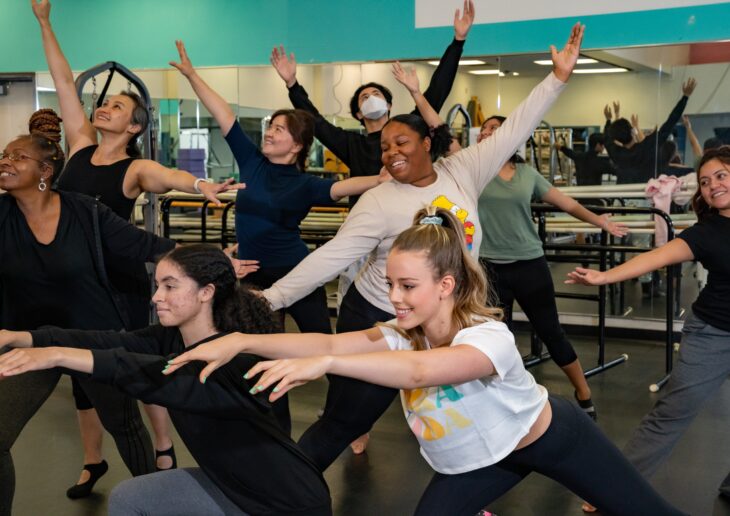Building the Future of Career Education: Innovative Marketing Campaign Boasts Five Years of Success Feature Story
March 23, 2023

In 2016, the California Legislature created the California Community College Strong Workforce Program with the mission to develop more workforce opportunities and lift low-wage workers into living-wage jobs by creating one million more middle-skill workers. At the heart of the program is the idea of “more and better” career education: “More” meaning increasing the number of students enrolled in community college programs, and “better” relating to improving overall career education programs.
In 2018, in order to recruit more students into programs that lead to high-demand and living-wage jobs, Orange County’s 10 community college institutions joined forces and used part of their Strong Workforce allocation to launch a first-of-its-kind regional career education marketing effort. The idea was to showcase the collective power of local community college programs by leveraging a large media budget, rather than having individual colleges compete with one another.
“Prior to the regional marketing effort, the region and each college would develop amazing programs but no one would know about it since marketing was not a priority,” says Tony Teng, Dean of Advanced Technology and Applied Science at Saddleback College and regional marketing project lead. “The regional marketing provides marketing expertise for every project that aligns with the approach developed for the entire region.”
In the five years that have followed, Orange County’s “Future Built” career education marketing campaign has developed a common website organized by industry sectors, launched a multi-million dollar marketing campaign, leveraged strategic research to help colleges better reach students, and added a bilingual career education liaison who assists students with finding a program and a college. In the process, the campaign has become an innovative exemplar of how to market career education on a regional level.
“It is easy to become siloed in higher education, but the Future Built marketing project is a great example of how working together towards a common goal makes us stronger and more effective,” says Dr. Alex Davis, Assistant Vice Chancellor of Economic Workforce Development and Executive Director of the Orange County Regional Consortium.
The impact of this centralized effort can be seen in a 2023 survey of students who visited the website:
- 73 percent of respondents were more interested in attending an Orange County community college career education program after visiting the site.
- 56 percent of those who visited the Future Built website subsequently applied to a local college, and 83 percent of those enrolled.
But this survey only tells part of this story—for many students the impact of the campaign is nothing short of life-changing. In 2019, Monica Trinidad was looking for a cosmetology program in her community when she found the Future BUILT website’s new chat feature. This put her in contact with the career education liaison, Gustavo Chamorro, Ed.D., who helped connect her to Fullerton College. There, a bilingual counselor helped her review the program’s offerings, complete the FAFSA for financial aid, and set her on the road to success.
Today, Monica is moving forward into her second semester. Her success has even inspired her children—her eldest daughter recently joined her in Fullerton College’s cosmetology program and her other daughter enrolled at Cypress College to become an esthetician.
“Looking back, I never thought I would have gotten this far,” explains Monica. “I had no clue where to start or what to do. But that all changed when I found the Future BUILT site and Gustavo. The best part is that by helping me, it helped my whole family.”
To engage prospects like Monica, the campaign continues to deploy an ever-evolving mix of traditional and cutting-edge media that ranges from career education viewbooks for high school counselors, to TikTok ads featuring influencers and students.
In 2022, the campaign’s digital tactics generated nearly 250,000 website visits; 10,000 visits to regional community college websites; 3,894 “apply button” clicks; and 1,596 direct phone calls, chats, and emails with potential students.
Among the campaign’s many highlights are a series of industry-focused ads that ran during the 2021 Summer Olympics one of which won a Gold Medallion from the National Council for Marketing and Public Relations.
In recent years, the general campaign has been supplemented by a number of smaller, strategic campaigns targeting specific audiences like stop-outs. Like many regions following the COVID-19 pandemic, Orange County found itself hit hard by declining enrollments. To better understand this decline and chart a path forward, a survey of 800 stop-outs was conducted which revealed, among other things, an increasing desire for short-term programs.
Armed with this information, a landing page, college-specific emails and texts, and a robust social media campaign in English and Spanish were all deployed to promote short-term certificates. Campaign highlights include:
- Over 25,000 visits to regional and college-specific pages in the first month
- Over 100,000 emails sent with a 59 percent open rate
- 150,000 text messages sent generating over 16,000 clicks to individual college pages
In 2021, a survey of 476 randomly chosen English and Spanish-speaking residents from Orange County was conducted to track the impact of the marketing campaign. Compared to a benchmark study conducted in 2018, the 2021 follow-up recorded a number of significant achievements.
- Unaided awareness of specific community colleges offering career education programs went up across the region.
- Specific knowledge of career education programs increased from 55 to 59 percent.
- Favorable impressions about whether community colleges are meeting the needs of the community, high school students, working adults, and regional businesses increased by 21% across all categories.
One survey respondent had this to say about the website: “It went into far more depth about each individual college. It also provided numerous amounts of benefits from each college, and what they specialized in.”
In addition to exemplary campaign performance, there are several regional data points worth noting.
- Career Education (CTE) enrollments were trending upward when the campaign started in 2018 prior to the pandemic. From 2018 (when the campaign started) to 2019, Orange County saw a 2.4 percent increase in CTE enrollments. By way of comparison, non-CTE enrollments during the same period decreased 3.7 percent.
- When the pandemic hit, enrollment for CTE programs declined 12.2 percent. In contrast, non-CTE program declined 16 percent.
- From 2018-2021, the percentage of Hispanic enrollment in career education programs increased by 4%. Asian student enrollment also increased 2%. The Future Built campaigns have been running for years in Spanish and Vietnamese to recruit these two populations. In the meantime, non-CTE programs only increased 1% for Hispanic students and remained flat for Asian students.
Additionally, completion data from Launch Board for the Orange County microregion shows success across a number of Strong Workforce Program metrics:
- An increase of 16.77% of CTE students who have earned a degree or certificate from when the campaign began in 2018 to 2021.
- Increases are also seen in students who earned a Chancellor’s Office-approved credit certificate, noncredit certificate, and any associate degree.
“While claiming a causal relationship between marketing and enrollment is always tricky, the overall impact of the Future Built campaign effort is significant because of the way it brings needed attention to regional workforce needs and job opportunities,” says Dr. Jesse Crete, Director of the Orange County Center of Excellence for Labor Market Research. “This work provides an important bridge between job demand, people who need jobs, and the community college programs that train for them.”
Even with these past successes, the Future BUILT campaign is already looking towards the future, including revamping the website to include direct links to each college program, offering customer service training for student-facing career education support personnel, and integrating a new focus on noncredit certificate programs.
In the end, the Future BUILT campaign’s success is not just an example of how innovative marketing can create real-world results, but a testament to what can be accomplished when a region works together in pursuit of a shared goal.




